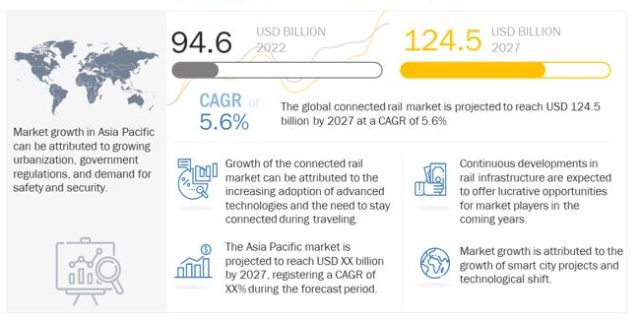
The global connected rail market size is projected to grow from USD 94.6 billion in 2022 to reach USD 124.5 billion by 2027, at a CAGR of 5.6%.The major factors behind the growth of rail systems & services market is the continuous need for safety and security in railways, commutator convenience, government support, growing economy, and increasing population. Continuous innovations in the application and advanced analytics of data management are promising to transform the railway industry and commuter experience. The connected technology helps improve safety, train control, traffic management, and visual automated monitoring on trains and platforms.
The Rolling Stock segment is expected to be the largest market during the forecast.
Increasing urbanization, rising demand for increased connectivity, and the comfort, reliability, and safety offered by rail transport have led to the growth of rail transportation. Rolling stock plays a vital role in the infrastructure of a city or a country. There is a rising demand for convenient, eco-friendly, and safe modes of transportation from commuters and governments. Increasing urbanization is driving the need for greater connectivity between newly developed suburban cities and metropolises, and inadequacies in the existing infrastructure have led to the need for new transit solutions. Locomotives are traditionally used to haul freight and passenger wagons for long-distance mainline transport. Metros, light rail vehicles (LRVs), and monorails are used for intracity as well as intercity transportation. Advancements in rail technology have led to the introduction of rolling stock such as electro-diesel locomotives, diesel multiple units (DMUs), electric multiple units (EMUs), high-speed trains, and Maglev, which are currently used commercially. However, the application of DMUs, EMUs, high-speed trains, and Maglev for transporting goods is yet to be introduced on a wider scale. Rail transportation consumes less energy and operates at a lower cost in comparison to alternate modes of transportation. The introduction of the Maglev and bullet train technology is also offering higher speeds for the transportation of goods and passengers along with reduced time. In 2021, China developed a bullet train to carry goods and considers it to be the fastest freight transport train with an operating speed of 350 km/hour.
Download PDF Brochure @ https://www.marketsandmarkets.com/pdfdownloadNew.asp?id=196887119
The Freight Wagon segment is estimated to lead the market during the forecast period
Freight wagons are rolling stocks that are used to transport goods and commodities. The railway is one of the many modes of transportation available for trade, and it is likely to be the cheapest. As compared to road transportation, this mode of transportation can carry a large amount of cargo in a single trip, while still taking less time over long distances than a maritime route. Governments all over the world are putting a premium on last-mile connectivity for trade, resulting in a boom in investment in logistical infrastructure. The number of projects to expand the railway network for inter-state and intra-state trade is growing. On similar grounds, innovations such as dedicated freight corridors are expected to boost trading opportunities, thus increasing the demand for freight wagons. In June 2021, Sinara Transport Machines Holding (STM) secured a contract from Russian Railways for the supply of 200 2TE5A freight diesel locomotives, which will be delivered by 2031. The locomotives will be equipped with electro-pneumatic brakes, sensors (to gather data on milage), and digital brake indicators.
North America is expected to be the largest market during the forecast period.
Freight traffic is high in North America. Freight railroads play an important role in the economy of the region, due to the movement of imports and exports and the shipments of coal and oil. The US Department of Transportation forecasts that freight railroad demand will increase to 88% by 2035. The railroads in the US are part of an integrated network that includes the railroads in Canada and Mexico, making it the world’s cheapest and most-efficient freight rail service network. The US government’s mandates on safety and security are directly going to drive the connected rail market. The US and Canada are the leading countries in the region as they witness significant advancements in terms of the development of smart cities and transportation projects. These countries have sustainable and well-established economic growth, empowering them to increasingly invest in R&D activities, thereby contributing to the development of new technologies in the connected rail market. In 2020, Wabtec Corporation announced a supply contract worth USD 120 with Virgin Trains USA to provide unique high-speed signaling and train control applications for the North American market.
Key Market Players
The global connected rail market is dominated by major players such as Robert Bosch GmbH (Germany), Siemens (Germany), Hitachi (Japan), Huawei (China), and Wabtec Corporation (US). These companies have strong distribution networks at a global level. In addition, these companies offer an extensive product range in this market. These companies have adopted strategies such as new product developments, deals and others to sustain their market position.
Request Free Sample Report @ https://www.marketsandmarkets.com/requestsampleNew.asp?id=196887119
Browse Related Reports:
Rolling Stock Market – Global Forecast to 2028
Railway Telematics Market – Global Forecast to 2026
Rolling Stock Management Market – Global Forecast to 2025

